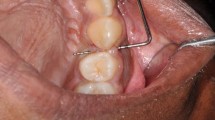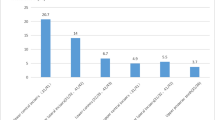Abstract
Many orthodontic treatments involve tooth extraction. Gingival invagination is a common side effect after orthodontic extraction space closure leading to compromised oral hygiene and the space closure being hampered. Even the long-term stability of the orthodontic treatment result may be jeopardized. The aim of this study was to identify risk factors for the development of gingival invagination and possible implications on oral health and orthodontic treatment results.
A total of 30 patients presenting 101 tooth extractions and subsequent orthodontic space closure were investigated to detect the presence of gingival invagination. The time required until active space closure, the thoroughness of space closure, and probing depths mesial and distal to the extraction site in addition to age, gender and the Periodontal Screening Index were investigated. A new coding system to describe the extent of gingival invagination is introduced for the first time here.
Gingival invagination developed more frequently in the lower jaw (50%) than the upper (30%). Complete penetration occurred in the upper jaw in 6% of the patients and in the lower jaw in 25%. All patients without gingival invagination revealed complete space closure, whereas only 70% in the group with gingival invagination did so. The time until initiation of space closure took significantly longer in patients with gingival invagination (7.5 ± 1.4 months) than in patients without (3.3 ± 0.8 months). Probing depths of the adjacent teeth were significantly greater in regions with invaginations.
Thus, the time required until space closure was initiated and the extraction site are important risk factors for the development of gingival invagination. The consequences of gingival invagination are instable space closure and deeper probing depths mesial and distal to the extractions. However, no statements concerning the mid- to long-term effects on oral health can be made.
Zusammenfassung
Die Zahnentfernung ist ein fester Bestandteil in vielen kieferorthopädischen Therapiekonzepten. Nach dem kieferorthopädischen Lückenschluss ist die Ausbildung einer Gingivaduplikatur eine häufige Nebenwirkung, welche die Mundhygiene und den Lückenschluss erschwert sowie die Stabilität des Behandlungsergebnisses gefährden kann. Ziel der Arbeit war es, Risikofaktoren für die Entstehung einer Gingivaduplikatur zu identifizieren und deren Auswirkung auf die Mundgesundheit und die Stabilität des kieferorthopädischen Therapieergebnisses zu ermitteln.
In dieser Untersuchung wurden 30 Patienten mit 101 Zahnextraktionen und darauf folgendem Lückenschluss auf das Vorhandensein von Gingivaduplikaturen untersucht. Neben Alter, Geschlecht und PSI (parodontaler Screening Index) wurden der Zeitraum bis zum aktiven Lückenschluss, die Vollständigkeit des Lückenschlusses und Sondierungstiefen mesial und distal der Extraktionsareale erhoben. Zur Beschreibung der Gingivaduplikatur wurde ein neues Kodierungsverfahren etabliert und erstmals eingesetzt. Gingivaduplikaturen traten signifikant häufiger im Unterkiefer (50%) als im Oberkiefer (30%) auf. Die komplette Sondierbarkeit lag im Oberkiefer bei 6%, im Unterkiefer bei 25%. Ein kompletter Lückenschluss lag in 100% der Fälle ohne Gingivaduplikatur, aber nur in 70% der Fälle mit Gingivaduplikatur vor. Durchschnittlich verging signifikant mehr Zeit in den Fällen mit Gingivaduplikatur (7,5 ± 1,4 Monate) als in Fällen ohne Duplikatur (3,3 ± 0,8 Monate), bis der Lückenschluss eingeleitet wurde. Die Sondierungstiefen der Nachbarzähne waren bei den Regionen mit Gingivaduplikaturen deutlich erhöht.
Festgestellt werden konnte, dass die Zeit bis zum aktiven Lückenschluss und die Lokalisation der Extraktion wichtige Risikofaktoren für die Entstehung einer Gingivaduplikatur darstellen. Folgen der Gingivaduplikatur sind ein instabiler Lückenschluss und erhöhte Sondierungstiefen mesial und distal der Extraktionen. Dennoch kann an dieser Stelle keine Aussagen über ihre mittel- bis langfristigen Folgen für die orale Gesundheit getroffen werden.




Similar content being viewed by others
References
Araujo MG, Lindhe J (2005) Dimensional ridge alterations following tooth extraction. An experimental study in the dog. J Clin Periodontol 32:212–218
Cardaropoli G, Araujo M, Hayacibara R et al (2005) Healing of extraction sockets and surgically produced – augmented and non-augmented – defects in the alveolar ridge. An experimental study in the dog. J Clin Periodontol 32:435–440
Cardaropoli G, Araujo M, Lindhe J (2003) Dynamics of bone tissue formation in tooth extraction sites. An experimental study in dogs. J Clin Periodontol 30:809–818
Diedrich P, Wehrbein H (1997) Orthodontic retraction into recent and healed extraction sites. A histologic study. J Orofac Orthop 58:90–99
Edwards JG (1971) The prevention of relapse in extraction cases. Am J Orthod 60:128–144
Gölz L, Reichert C, Jäger A (2011) Gingival invagination – a systematic review. J Orofac Orthop 72:409–420
Kurol J, Rönnerman A, Heyden G (1982) Long-term gingival conditions after orthodontic closure of extraction sites. Histological and histochemical studies. Eur J Orthod 4:87–92
Malkoc S, Buyukyilmaz T, Gelgor I, Gursel M (2004) Comparison of two different gingivectomy techniques for gingival cleft treatment. Angle Orthod 74:375–380
Meyle J, Jepsen S (2000) Der parodontale Screening-Index (PSI). Parodontologie 1:17–21
Parker GR (1972) Transseptal fibers and relapse following bodily retraction of teeth: a histologic study. Am J Orthod 61:331–344
Pinheiro ML, Moreira TC, Feres-Filho EJ (2006) Guided bone regeneration of a pronounced gingivo-alveolar cleft due to orthodontic space closure. J Periodontol 77:1091–1095
Proffit WR, Fields HW, Sarver DM (2007) Orthodontic treatment planning: limitations, controversies, and special problems. In: Proffit WR, Fields HW, Sarver DM (eds) Contemporary orthodontics. Mosby Elsevier, St. Louis, MO, USA
Reed BE, Polson AM, Subtelny JD (1985) Long-term periodontal status of teeth moved into extraction sites. Am J Orthod 88:203–208
Reichert C, Wenghoefer M, Götz W, Jäger A (2011) Pilot study on orthodontic space closure after guided bone regeneration. J Orofac Orthoped 72:45–50
Rivera Circuns AL, Tulloch JF (1983) Gingival invagination in extraction sites of orthodontic patients: their incidence, effects on periodontal health, and orthodontic treatment. Am J Orthod 83:469–476
Robertson PB, Schultz LD, Levy BM (1977) Occurrence and distribution of interdental gingival clefts following orthodontic movement into bicuspid extraction sites. J Periodontol 48:232–235
Tiefengraber J, Diedrich P, Fritz U, Lantos P (2002) Orthodontic space closure in combination with membrane supported healing of extraction sockets (MHE) a pilot study. J Orofac Orthop 63:422–428
Wehrbein H, Fuhrmann R, Andreas A, Diedrich P (1993) Die Bedeutung von Gingivaduplikaturen beim orthodontischen Lückenschluß. Eine klinisch-radiologische Studie. Fortschr Kieferorthop 54:231–236
Acknowledgments
The authors would like to thank the Al-Dente Alumni Club e. v. of the University Hospital of Bonn for their financial support.
Danksagung
Die Autoren möchten sich bei dem Al-Dente Alumni Club e.V. der Universitätszahnklinik Bonn für die finanzielle Unterstützung bedanken.
Conflict of interest
On behalf of all authors, the corresponding author states that there are no conflicts of interest.
Interessenkonflikt
Der korrespondierende Autor gibt für sich und seine Koautoren an, dass kein Interessenkonflikt besteht.
Author information
Authors and Affiliations
Corresponding author
Additional information
The first two authors contributed equally to this study.
Parts of this paper were presented at the 84th annual DGFKO (Deutsche Gesellschaft für Kieferorthopädie – German Orthodontics Society) conference in Dresden.
Rights and permissions
About this article
Cite this article
Reichert, C., Gölz, L., Dirk, C. et al. Retrospective investigation of gingival invaginations. J Orofac Orthop 73, 307–316 (2012). https://doi.org/10.1007/s00056-012-0082-3
Received:
Accepted:
Published:
Issue Date:
DOI: https://doi.org/10.1007/s00056-012-0082-3




